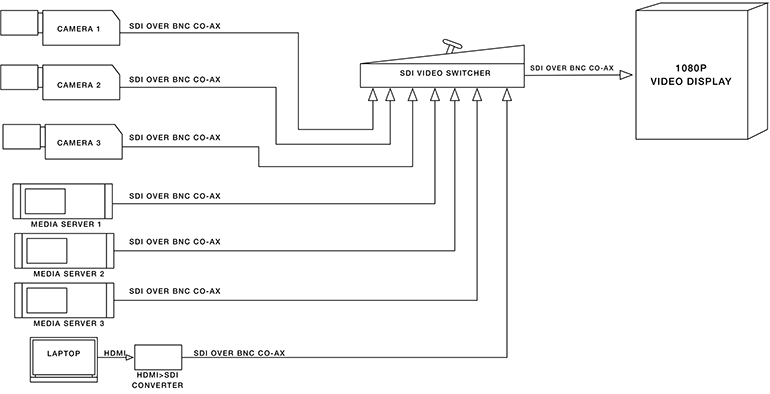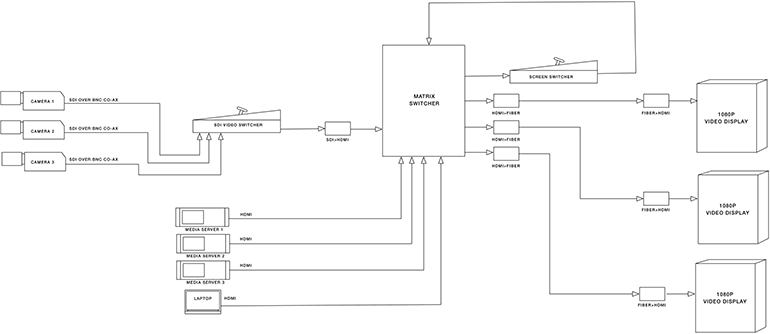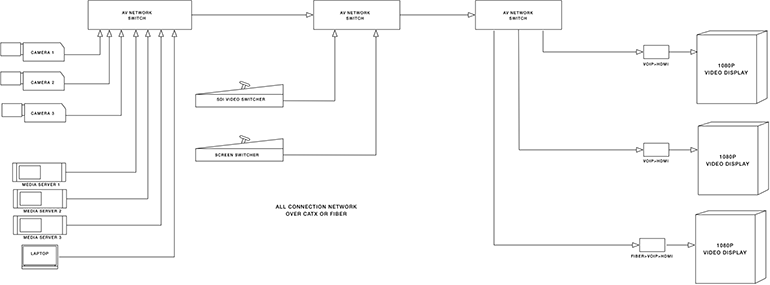A few years ago, after giving a presentation on the “Future of Display” at LDI, I made a narrowly controversial statement. I was asked, “When will professional video presentation systems used in live events be completely wireless?” My response? Never, that’s when. Once the cries of “heresy!” died down, I explained that my belief is that the bandwidth and reliability demands of high-end video display systems will always exceed the capability of wireless systems and that hardware, not waves traveling through the air, will be needed, at least during my lifetime.
Whether you agree with my prediction or not, it is safe to say that today’s video presentation systems require wire and other bits of hardware to transmit signals from the output of one device to the input of another. Also, now that network-based video transmission systems have begun to penetrate the marketplace, a primer on the various transmission systems seems like good idea.

HDBase-T
Another transmission protocol using twisted-pair cable is HDBaseT, a consumer electronics initiative that aimed to put every type of signal on the same transmission path, including high-resolution video, audio, Ethernet, and other control protocols, and run it down the same standard Ethernet cable. HDBaseT has not penetrated the live entertainment industry to any great extent but it has found a place in the permanent install market where the benefit of piggy-backing existing standard cable with all manner of signals is a big cost-saver. Plus, HDBaseT’s power transmission capabilities are attractive as it cuts down on the “wall-warts” that other systems may require.
Note that while some equipment such as projectors may have built-in HDBaseT connections, using HDBaseT may require a “dongle” that attaches to the send or receive devices. HDBaseT connections are virtually non-existent on devices often used in live events, including switchers, media servers, and the like.

SDI
If you happen to be working with a system that has a prevalence of SDI connections (HD, 3g, 12g), the transmission choices are somewhat different, as the SMPTE protocols that govern SDI support un-boosted cable runs of up to 1,000 feet using co-axial cable. An example and drawing helps illustrate how SDI differs from other video signal transmission schemes.
In the simplified example (Fig. 1), sources for the display system include video cameras, media servers, and a laptop. All the sources feed a broadcast-style effects switcher that provides the signal to the audience display. The cameras and the media servers are native SDI, and the laptop has an HDMI output. All devices are configured to run at 1080P (3g-SDI).
The approach illustrated has the cameras and media servers connect to the switcher via SDI over co-axial cable. The laptop is converted to SDI and also connected to the switcher via co-axial. The switcher output is converted to SDI-over-fiber and runs to the display where the signal is converted back to co-axial.
One question that the example brings up is why convert to fiber if the display connection is only 100m distant and SDI can easily bridge that distance using co-axial cable? The answer lies in the experience of humping 50m lengths of co-axial cable, which is typically heavy and stiff. Much easier on the crew to convert to fiber.
Another legitimate question related to SDI is: Why isn’t it used more often in live events, since it has the advantage of simplicity plus reliability? There are two main reasons that limits SDI use in live events. First, much of the video equipment used in live events, such as media servers, LED processors, and computers do not come with SDI as standard connections so conversion is required. Second, HD-SDI, the most common SDI protocol, is not tolerant of non-TV standard resolutions such as 1200 x 1920. However, assuming 3g and 12g SDI take hold, that will change.

Video Over IP
Though fairly rare in live event work, VOIP is quickly gaining recognition within the industry as a powerful approach to signal transmission. However, the architecture is so far removed from the typical “point-to-point” wiring that has been in use for decades that going VOIP requires a major re-think and re-education for users.
In simplest terms, video-over-IP is a system that utilizes network packets of data to transfer video from one or more devices to one or more destinations. Networked system for audio and lighting control, such as Dante® or ACN, utilize a similar architecture. However, like all things video, VOIP is more complicated due to the vast quantities of data that high-resolution/low-compression video streams require, as well as the low-latency and synchronization demands of most systems.
To illustrate the benefits of VOIP for live event work, drawings Fig. 2 and Fig. 3 will help. Fig. 2 shows a simplified point-to-point architecture representing the conventional system architecture and compares it to a IP-based system. Note that the matrix switch is the common point for all of the video signals and compare that to the relative simplicity of the VOIP version in Fig. 3.
For a major live event, the hurdles for successful implementation of a VOIP architecture are significant, mainly due to lack of experience in sophisticated networking systems amongst video technical staff. While many of the manufacturers pushing VOIP systems claim “plug and play” implementation, the likelihood is it will take some time for the industry to educate the people responsible for deploying and supporting these systems.
The benefits of VOIP are undeniable due to the system’s inherent flexibility, signal accommodation, ease of wiring, and centralized control. It will become the de facto standard for video system architecture at some point in the future but for now, just selecting the products is a bit of a minefield with many proprietary and a few standardized products competing for market share.
Closing
The transition from traditional point-to-point transmission system to network-based is upon us and requires further examination, so keep your eyes open for a future article dedicated to the selection and theoretical implementation of a VOIP system for a large-scale one-off live event.
References